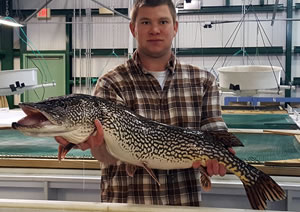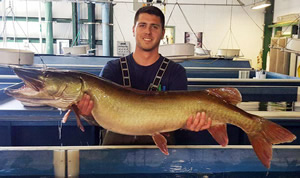  |
Hackettstown State Fish Hatchery - 2018 Broodstock Collection and Spawning |
|
by Craig Lemon
Hatchery Superintendent
August 28, 2018
Every year staff from the Hackettstown State Fish Hatchery visit select northern New Jersey waters to obtain mature Northern Pike, Walleye and Muskellunge to serve as "broodstock" for the state's coolwater stocking programs. These broodstock fish are brought to the hatchery where they provide eggs which are fertilized and incubated in specialized tanks. The resulting fry and fingerlings are grown in both larger indoor tanks and/or outdoor rearing ponds to grow to stockable size.
Northern Pike
The production season kicks off each year with broodstock collection for Northern Pike in Budd Lake. Northern Pike spawn within a narrow time frame following ice-out. Ever changing weather patterns, especially unseasonable warm trends, can make it very difficult to pinpoint the start of the spawning season. It's funny reading the summary from 2017 and seeing this statistic: "Over the Bureau of Freshwater Fisheries' 37 years of broodstock collection, the season on Budd Lake has started as early as March 3rd in 1998 and as late as April 6 in 2015 depending on the severity of winter and timing of ice out." With ice coming off early, lake water temps already in the low 40's, and a cold long range forecast the call was made to set nets a full five days earlier than we ever had before. Once again, we were asking ourselves, "Will the pike be ready to spawn this early?" The crew placed three South Dakota style trapnets in Budd Lake on February 26th. And to answer the question, yes, the pike were ready.
|
|
In the three days following, 84 adult pike were captured. The pike catch consisted of 43 males and 41 females. Of the 41 females, 12 came in ripe, 21 unripe, and 8 were spent. In all, 14 females were spawned at the hatchery producing 510,040 eggs for an average of 37,780 eggs per female. The nets captured a total of 2,712 fish representing 14 different species. Black Crappie, White and Yellow Perch, and variety of sunfish made up the majority of the catch. Staff only bring the pike back to the hatchery for spawning; all other fish are released on the spot. Lake temperatures ranged between 40 - 45 degrees.
Egg take: February 27 - March 4
Egg hatch: March 8-13
Stocking six-inch fingerlings: May 21 - June 1 (74 days after hatch)
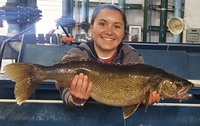
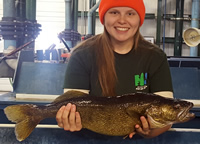
Click images to enlarge
|
Walleye
As was predicted at the end of February by weather forecasters, New Jersey's early spring turned to winter again for the next month. Lake water temperatures dropped and some lakes even refroze. For the second year in a row staff played the waiting game for snow and ice to melt off Swartswood Lake.
A full month after pulling Northern Pike nets from Budd Lake, staff set Walleye nets on April 2nd. Walleye trapnetting at Swartswood over the past 18 years has kicked off as early as March 15th in 2016 and as late as April 6th in 2015. As always, the net was placed near the mouth of Neldon Brook. In total, 228 Walleyes were captured. The Walleye catch was made up of 149 males and 79 females. An interesting statistic was that only 20 other fish were captured in the net during the four days the nets were set. Typically, hundreds of other fish are captured and returned to the lake, but staff presumed that the lower than normal water temps, 40 to 43 degrees, probably kept most fish movement to a minimum.
Of the 79 female Walleye captured, 69 came in ripe, eight unripe, and two were spent. A total of 74 females were spawned at the hatchery producing just over six million eggs, an average of 82,000 eggs per female. Ninety-four percent (94%) of the females captured were spawned - one of the highest percent rates ever, once again pointing to the crew hitting the spawning run just right.
Egg take: April 3-6
Egg hatch: April 18-21
Stocking 1.5-inch fingerlings: June 6 (49 days post-hatch)
Stocking 4-inch fingerlings: July 17 (90 days post-hatch)
|
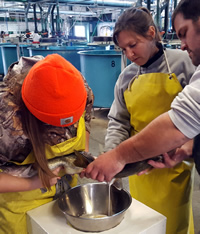
Click image to enlarge |
|
Muskellunge
Phase three of the trapnetting season is the search for "The Fish of 10,000 Casts", the purebred Muskellunge. Netting dates over our 22 years have ranged from an early start of March 27 in 1999 to as late as April 19 in 2007. This year kicked off April 12th, when the crew set two Pennsylvania Style trap nets in Greenwood Lake, one near the mouth of Belcher's Creek and a second across the lake in a spot known as the "State Land Set".
The nets captured only eight muskies, two males and six females well below the impressive 29 from 2017. Of the six females captured, two came in ripe, three unripe, and one spent. A total of five females were spawned in the hatchery yielding 411,075 eggs, an average of 82,215 per female. It's thought that with water temps ranging from 46 to 50 that the cooler water kept Muskie spawning activity down. Last year water temps reached 62 by the end of the spawn. This year's Greenwood nets yielded 1,637 fish, including 24 Walleye, and good numbers of Yellow and White Perch, Alewives, Black Crappies, and a variety of sunfish.
The following week hatchery staff and their nets made their way south to Echo Lake Reservoir in Newark's Pequannock Watershed and set two Pennsylvania and one South Dakota style trapnets in search of a handful of ripe Leech Lake strain Muskies. The three nets were fished from April 23 to April 27 capturing 14 muskies, six males and eight females. The nets were checked three times, with four muskies on April 24th, six on the 26th, and four females on the 27th. Six were ripe females; three were spawned with Echo Lake males producing a nice incubation jar with 117,000 eggs. The three other ripe females were crossed with 10 male Northern Pike to make a jar of 52,000 Tiger Muskie eggs. The nets captured a total of 395 fish representing 11 other non-target species such as Bluegill, Black Crappie, Yellow Perch, and Smallmouth Bass. Water temperatures ranged from 50 to 52 degrees. Muskie females typically ripen when water temperatures reach 50 degrees.
Between the two lakes, a total of 10 female muskies were spawned producing about 713,000 eggs. The last of the eggs hatched May 12. This year's Muskellunge eggs hatched at a rate of 29%, well below the 24-year average of 47%, producing 210,000 fry.
Once hatched the fry spend the next seven to 10 days basically lying on the bottom of the tank feeding off their yolk sacs (hence the name "sac fry"). Once the yolk sac is absorbed they are able to leave the tank bottom and become free swimming (swim-up fry). At this point hatchery staff do weight counts and inventories, setting up 100,000 swim-up fry in ten 350-gallon round tanks.
The next 15 days are difficult as hatchery staff begin to convert the fry onto dry pelleted diets: Muskellunge, unlike other Esoscid Family members which include Northern Pike and Tiger Muskellunge (hybrid), insist on eating a moving food source as opposed to dry feed just slowly dropping straight down through the water column. This requires a food conversion which consists of "cooking" and hatching small batches of brine shrimp eggs and feeding the shrimp five times per day to the Muskie fry. The brine shrimp to dry feed conversion in the hatchery's 10 circular fiberglass tanks was our best ever, ranging between 56-84 percent success with the average being 66%. This greatly surpasses our typical 30-40%. Two reasons for this improvement are believed to be having to run both recirculation systems because of replacement of the 68-degree system UV filter, and starting the system for the earliest ever Northern Pike spawning in Budd Lake.
Over the 15-day period the tiny fry are fed live brine shrimp, each day mixing in more dry feed, slowly weaning the fry off of the shrimp at the end of the two-week period. As the fry are growing the feed particle size is increased every couple of days, and the fish begin to go for the larger pellets as soon as it is introduced.
Feeding brine shrimp and continually hand feeding helps reduce cannibalism, which can be their biggest obstacle. Daily cleaning of these round culture tanks with these tiny fry is a tedious process and takes extreme care. The Muskie fry are raised both indoors in circular fiberglass tanks and outdoors in earthen ponds. The target number for many years has been 12,000 ten-inch fingerlings by November 1st. Following the recent multi-year Coolwater Assessment by Bureau biologists, hatchery staff have been asked to produce and distribute 4,400 Fall 10-inch fingerlings and 3,800 12-14-inch Spring Yearlings. They will be stocked in 11 waters with each getting yearlings on alternating years.
Egg take - 4/17 - 4/26
Egg hatch - 5/2 - 5/12
Stocking 10-inch fingerlings - 10/15 (166 days post hatch)
Stocking 17-inch yearlings - 8/2019 (about 450 days post hatch)
All adult muskies handled at the hatchery over the past 20 years have been tagged with orange streamer tags inserted near the base of the dorsal fin. To date over 615 Muskellunge have been tagged. This year, 5 of the 22 (23%) Muskellunge trapnetted were previously tagged. The tags bear the message "CALL HACKETTSTOWN HATCHERY (908) 852-4950" along with a tag number. Anglers, who call in to report catching a tagged fish will be told when the fish was tagged, and its length and weight at the time of tagging. Reports of tagged fish provide the hatchery and state fisheries biologists with important growth information on the state's Muskellunge fisheries.
|
|
Fish For the Future
In coordination with Bureau of Freshwater Fisheries biologists, the Hackettstown Hatchery is raising the following numbers of Northern Pike, Walleye and Muskellunge to meet the state's needs for 2018:
28,372 six-inch Northern Pike fingerlings for stocking in:
Pompton Lake and Pompton River (Passaic); Spruce Run Reservoir (Hunterdon); Budd Lake (Morris); Farrington Lake (Middlesex); Millstone River (Somerset) and the Passaic River (Morris).
Cranberry Lake (Sussex) surplus only
4,379 ten-inch Fall Muskellunge fingerlings/3,738 twelve-inch Spring yearlings for stocking in:
Greenwood Lake, Monksville Reservoir and Echo Lake Reservoir (Passaic); Lake Hopatcong (Morris/Sussex); Mercer Lake (Mercer); Mountain Lake and Furnace Lake (Warren); Little Swartswood Lake (Sussex); and DOD Lakes (Salem).
Manasquan Reservoir (Monmouth) surplus only
Carnegie Lake (Mercer) surplus only
Cooper River Lake (Camden) surplus only
95,264 two-inch & 23,816 four-inch Walleye fingerlings for stocking in:
Lake Hopatcong (Morris/Sussex), Swartswood Lake (Sussex), Greenwood Lake (Passaic), Canistear Reservoir (Sussex), Monksville Reservoir (Passaic). Surplus Walleye will be stocked in the Delaware River (Sussex/ Warren).
Below are summary tables of fish collected in spring, 2017.
NORTHERN PIKE
| WATERBODY |
# DAYS NETS
WERE SET |
# FISH CAUGHT |
AVG. LENGTH (INCHES) |
RANGE
(INCHES) |
AVG. WEIGHT
(POUNDS) |
RANGE
(POUNDS) |
| BUDD LAKE |
3 |
84 |
25.9 |
18.8 - 39.1 |
4.31 |
1.44 - 16.06 |
| Males |
|
43 |
23.4 |
18.8 - 32.5 |
2.72 |
1.44 - 6.14 |
| Females |
|
41 |
28.5 |
20.2 - 39.1 |
5.97 |
1.77 - 16.06 |
MUSKELLUNGE
| WATERBODY |
# DAYS NETS
WERE SET |
# FISH CAUGHT |
AVG. LENGTH (INCHES) |
RANGE
(INCHES) |
AVG. WEIGHT
(POUNDS) |
RANGE
(POUNDS) |
| GREENWOOD LAKE |
7 |
8 |
38.8 |
36.0 - 42.5 |
15.2 |
12.04 - 19.18 |
| Males |
|
2 |
37.3 |
36.0 - 38.5 |
12.7 |
12.04 - 13.38 |
| Females |
|
6 |
39.4 |
37.4 - 42.5 |
16.0 |
13.18 - 19.18 |
| ECHO LAKE RESERVOIR |
4 |
14 |
41.3 |
29.5 - 49.5 |
19.5 |
5.6 - 32.98 |
| Males |
|
6 |
37.1 |
29.5 - 42.5 |
14.1 |
5.6 - 21.5 |
| Females |
|
8 |
44.5 |
35.8 - 49.5 |
23.6 |
12.06 - 32.98 |
WALLEYE
| WATERBODY |
# DAYS NETS
WERE SET |
# FISH CAUGHT |
AVG. LENGTH (INCHES) |
RANGE
(INCHES) |
AVG. WEIGHT
(POUNDS) |
RANGE
(POUNDS) |
| SWARTSWOOD LAKE |
4 |
228 |
201 |
14.5 - 27.1 |
3.48 |
1.2 - 10.04 |
| Males |
|
149 |
19.1 |
14.5 - 22.6 |
2.85 |
1.2 - 5.12 |
| Females |
|
79 |
21.6 |
16.4 - 27.1 |
4.65 |
1.94 - 10.04 |
While reading through this information you might ask wow they take a lot of eggs and hatch a lot of fry where do most of them go? Unlike species such as Rainbow Trout and Channel Catfish that typically hatch at rates in the 90% range, these species hatch rates can vary from 0 to 70%, typically values in the 50% range are considered good. We set up a number of fry that we are comfortable with that will meet our final stocking needs. After that, surplus fry may be stocked in other water bodies or offered to other States in trade. In 2018, surplus hatchery fry from the Hackettstown State Fish Hatchery helped fisheries programs in four other states including Pennsylvania, New York, Massachusetts, and Connecticut. We have been trading surplus Northern Pike fingerlings for Landlocked Salmon yearlings with Massachusetts for a number of years and an exciting Salmon fishery is developing in three North Jersey waters.
The Hackettstown State Fish Hatchery also raises 12 other species of fish for waters throughout the state - see the production and stocking summaries for details. All fish raised at the Hackettstown Hatchery are stocked in public waters throughout the state to provide recreational fishing for licensed anglers and their families. The hatchery also raises several species of fish to assist the state's mosquito control efforts. The hatchery stocks 2-3 million fish annually. The hatchery had its best year ever in 2017, stocking a record 5 million fish.

The Hackettstown Hatchery is supported entirely through the sale of fishing licenses and federal Sport Fish Restoration Program grant monies generated from the sale of fishing equipment.
RELATED PAGES
|

